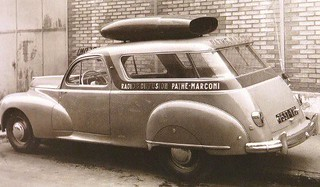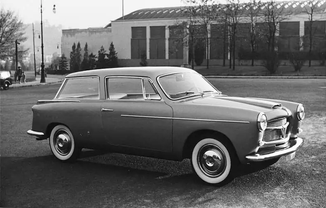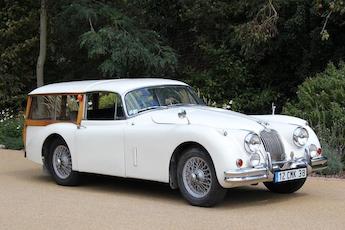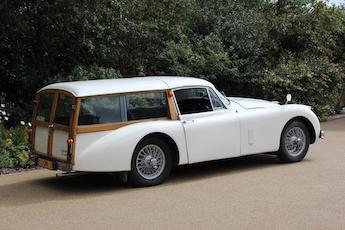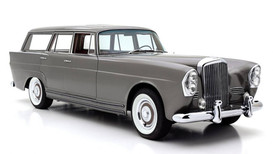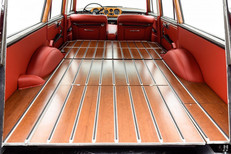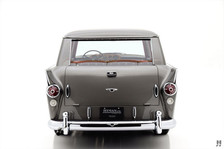World's Largest "Shooting Brake" Archive (Part 2 of 3)
- Story Cars
- Sep 20, 2021
- 32 min read
The auto industry hasn't a single universal definition for a "shooting brake." Long story short, there's confusion between what constitutes a "shooting brake" from a stations wagon, 2+2, coupe, hatchback, sports wagon, etc. So, this article was inspired by the hopes of settling the confusion and informing enthusiasts about the history and evolution of these automotive body styles that began as horse-drawn vehicles.
The Shooting Brake Archive
Part 1
Part 2
1951 Peugeot 203 Pathé Marconi
1952 Ferrari 212 Export Shooting Brake
1952-1954 Allard P2 Safari Shooting Brake
1953 Bentley R-Type Shooting Brake
1954 Chevrolet Nomad Concept
1954 Miller Shooting Brake
1956 Pontiac Safari
1956 Fiat 1100 TV Speciale Shooting Brake
1958 Porsche 356 Kruezer
1959 Rolls-Royce Silver Cloud I
1959 Jaguar XK150 3.4-Litre 'Foxbat' Sports Estate
1959 Bentley S2 Shooting Brake
1959-1978 Saab 95
1958 Tornado Cars LTD Typhoon Sportsbrake
1960 Sunbeam Alpine Shooting Brake
1960 Bentley S2 Wendler Shooting Brake
1961-1967 Ford Anglia 105E Estate
1961 Ford Thunderbird Custom Wagon
1962 Ford Thunderbird Wagon
1962 Ferrari 250 GT SWB 'Breadvan'
1962 Lagonda Rapide Shooting Brake
1964-1965 Aston Martin DB5 Shooting Brake
1964 Chevrolet Chevelle 300 Wagon
1965 Chevrolet Chevelle Wagon
1965 Plymouth Valiant Barracuda Wagon
1965 Ferrari 330 GT 2+2 Shooting Brake Vignale
1965 Ford Mustang Shooting Brake by Cumberford
1965 Iso Rivolta Breadvan
1965 Ogle Triplex Scimitar GTS
1965-1967 Aston Martin DB6 Shooting Brake by Harold Radford
1966 Ford Mustang Shooting Brake Prototype
1966 Ford Galaxie Magic Cruiser Concept Car
1966 Triumph Vitesse 2-Litre Estate
1966 Lamborghini 400GT Flying Star II
1966 Mercedes-Benz 230 SLX Shooting Brake by Frua
1967 Aston Martin DB6 Shooting Brake by FLM Panelcraft
1967 Ferrari 330 GT 2+2 'Navarro' Drogo
1967 Fiat Dino Parigi
1968-1975 Reliant Scimitar GTE (SE5/ 5A)
1968 Chevrolet Corvette Stingray Shooting Brake
1968 Jaguar XK150 Estate
1968 Fiat Dino Ginevra
1968 Fiat 125 Station Wagon
1968 Opel Kadett L Shooting Brake
1969 Intermeccanica Murena 429 GT
1970 Cadillac Eldorado Station Wagon Concept by George Barris
1970 Porsche 914 by Eurostyle
1970 Chevrolet Camaro Kammback Concept
1970 Mazda RX-500 Shooting Brake Concept
1970 Aston Martin DBS Shooting Brake
1971-1973 Volvo P1800 ES
1971 Cadillac Eldorado Wagon
1971 Dodge Challenger Wagon
1971 Opel GT 24 Hours of Lemons Breadvan
1971 Glibern Invader Estate
1971 Isuzu Bellett Sport Wagon by Ghia
1971 Toyota RV-1 Concept
1971 TVR Zante (SM-250)
1971 Lotus Elan Hexagon Shooting Brake
1971 Peugeot 504 Break Riviera
1972 Chevrolet Vega Kammback
1972 Reliant Scimitar GTE Ferguson 4×4 Prototype
1972 Ferrari 365 GTB 4 Shooting Brake
1972 Toyota RV-2
1972 Citroën SM Break de Chasse
Part 3
1951 Peugeot 203 Pathé Marconi Shooting Brake

1951 Peugeot 203 Pathé Marconi advertising Shooting Brake was converted for the Tour de France. It was designed by Philippe Charbonneaux and bodied by Antem.
1952 Ferrari 212 Export Shooting Brake
The first known Ferrari Shooting Brake is based on the 212 Export Spyder. It was converted into a shooting brake in 1952 and served as a support car during the 1952 Carrera Panamericana. Unfortunately, it was converted back into a Spyder soon after. The conversions were done by the Italian coachbuilder Paolo Fontana.
1952-1954 Allard P2 Safari Shooting Brake

Allard was never known for producing cars in great numbers, and the P2 is no exception, with only ten examples being built from 1952 to 1954. In fact, out of the ten originals, only four survive to this day.
The P2 could be ordered with a wide range of engines, built by Ford, Mercury, and Cadillac, the latter being a 5.4 litre V8. The latter produced 160 horsepower, or 119 kilowatts, but made up for the lack of horsepower with almost 270-foot pounds of torque. These engines are also very easily modified, making the Safari a prime candidate for a fantastic sleeper.
1953 Bentley R-Type Shooting Brake
This particular R-Type was converted into a shooting brake in the early 1960s – it is believed to carry gun dogs – by W M Collett & Sons of Gloucester. The accompanying original logbook shows that the car was first registered to H A Fox & Co Ltd, Rolls-Royce and Bentley Retailers of London W1, while its first private owner was Frank G Andreae of London W2.
1954 Chevy Nomad Concept

At the 1954 General Motors Motorama in New York City, GM introduced their Chevrolet Nomad show car. It was a sporty wagon with two doors, pleasant smooth flowing curves, a trademark Corvette grille, and a forward sloping B-pillar. Five examples were produced for the auto show circuit, and it is believed that three are still in existence. The response to the Nomad was positive and convinced Harley Early and his Design Studio to apply the looks and the name to the following year's station wagon. Production of the Nomad would remain from 1955 through 1961.
The two-door station wagon was a popular item among the 'surf culture' of the late 1950s and later with hot rodders. The Nomad name would return in 1965 and 1965 as a two-door Chevelle station wagon. Throughout the rest of the 1960s, the name was applied to the low-level Chevelle station wagon. In the 1970s and early-1980's, it was even offered as a G-Series full-size van model.
1954 Miller Shooting Brake

Geoffrey Miller of Cornwall, England was a craftsman who had earlier built his own motorcycle when he decided to build himself a station wagon. This is the result, and it is the only such example. Most homebuilt cars look, well, home-built. However, this has all of the look of a series production car from 1950s England.
Somewhat Allard-like in its appearance, a 2.9-liter Austin-Healey straight-six powers the four-door woodie wagon. He used some production parts that were readily available but is said to have done the body and woodwork by hand.
1956 Pontiac Safari
The sporty Nomad/Safari wagons started with a 1954 General Motors Motorama concept car, a two-door hatchback built from the newly introduced Corvette. It was a hit at auto shows, but GM officials decided to get more buyers by basing the stylish wagon look on the Chevrolet Bel Air and Pontiac Star Chief, the automakers’ top models. The then-radical design proved popular, but with more admirers than buyers, most of whom ended up with more practical sedans and four-door wagons instead of Nomads or Safaris. The style lasted through the tri-5 era of 1955-57, with the names later recycled for “normal” station wagons.
1956 Fiat 1100 TV Speciale Shooting Brake
This Fiat 1100 TV Speciale was an advanced idea for a “shooting brake” model, one of the first seen in Italy, an ideal car for the golf players like Sergio Pininfarina. Unveiled at the Pininfarina stand of the 1955 Turin Auto Show, it didn’t follow a production series.
1958 Porsche 356 Kreuzer
In late 1955, the 356 A was introduced with more powerful engine options, a newly standard front sway bar paired with softer front springs, longer rear shocks, and a windshield gently curved to allow for improved outward visibility. The updates were subtle and didn’t dilute the 356’s personality, though they did alter its character for the better. These cars retained the purity of design of the original 356, a look that would become slightly more complex when the car was updated again in late 1959. What didn’t change through the 356’s entire production run was its usability, for it was a sports car that could be second as a practical touring car.
For John Dixon of the Taj Ma Garaj, what passed for utility in Zuffenhausen was only the starting point. Working with artist Byron Kauffman of Daytona Beach, Florida, Dixon sketched out a 911 with a sedan delivery body that would provide the rear-engined car with a relatively vertical, side-hinged cargo door and plenty of storage behind. After deciding that the low-slung 911 didn’t lend itself to the concept as well as the 356, Dixon entrusted Bob Bennett of Bennett’s Rod Shop west of Dayton, Ohio, with bringing his idea to life. The car would eventually become known as the “Kreuzer,” a Germanized version of “cruiser.”
1959 Rolls-Royce Silver Cloud I
This 1959 Rolls Royce shooting brake has the standard 4,887 cc F-head in-line six-cylinder engine mated to a smooth four-speed automatic transmission. This is the older traditional Rolls-Royce engine that is both wonderfully smooth and wonderfully reliable. It's a perfect match for the style and purpose of the vehicle. Suspension is the standard independent front with unequal wishbones and coil springs and semi-elliptical leaf springs with a live axle at the rear, which is a perfect choice for a vehicle that will be expected to carry a significant load from time to time.
It is an example of the last of the halcyon days of Rolls-Royce when they were still building cars for adventurous clients and not just for those looking simply for status. It is a car that marks the end of an era. We hope it goes to an appreciative home and to a new owner who will use it in the spirit of the adventurous Rolls-Royce owners of old.
1959 Jaguar XK150 3.4-Litre 'Foxbat' Sports Estate
The 'sports estate' concept is not new; there had been several such bespoke creations on quality chassis before WW2. Harold Radford's dozen-or-so shooting brake conversions of the Aston Martin DB5 are among the most familiar in the post-war era. One of only two made, and believed the sole survivor, the example offered here resided in France for many years before coming to the UK in 2008 since it has been carefully stored. The creator of the Foxbat, though, remains unknown. It is believed that the car, which incorporates Morris Minor Traveller panels, was created to serve as a motorsports support vehicle.
1959 Bentley S2 Shooting Brake
This unique left-hand drive Bentley S2 features shooting brake coachwork by Harold Radford Ltd., the exclusive London firm established in the late 1940s. Radford’s first design was for a wooden-framed estate car body on the Bentley MkVI chassis. This ‘Countryman’ model was an immediate success, winning the 1948 Concours d’Elegance at Cannes. The Countryman was later refined, becoming an early version of the ‘hatchback’ concept applied to the standard saloon body on Bentley and Rolls-Royce chassis and those of other prestigious makes. Radford exhibited in the coachbuilding section at the London Motor Show from 1951 to 1963, winning numerous awards, and in the 1960s began to reach a wider public with its luxurious Mini conversions. H R Owen acquired the firm in the early 1960s.
1959-1978 Saab 95

The Saab 95 is a seven-seater, two-door station wagon produced by Saab from 1959 to 1978.
Initially, it was based on the Saab 93 sedan, but the model's development throughout the years followed closely that of the Saab 96 after the 93 was taken off the market in 1960. It was introduced in 1959, but because only 40 were made in 1959, production is often said to have started in 1960.
The first engine was an 841 cc three-cylinder two-stroke, but from 1967 onward, and it became available with the same four-stroke Ford Taunus V4 engine as used in the Saab 96, the Saab Sonett V4 and Sonett III, and the German Ford Taunus. It had a four-speed manual transmission. There was a small handle on the firewall that, when pushed, put the car into a "freewheeling" mode. This allowed the driver to coast downhill without seizing the two-stroke engine, but when power was needed, the transmission would engage, and the driver could power the car uphill again. The 95 received the four-speed gearbox before the 96 (that still had the old three-speed unit). It was also used for rallying.
1958 Tornado Cars LTD Typhoon Sportsbrake

Tornados were a British outfit that built cars in the '50s and until 1964 when they stopped producing cars and became a successful body shop. Their vehicles had very cool names like; Typhoon, Tempest, Thunderbolt, and of course Sportbrake. They were an early version of today's kit cars by being available fully built or as a kit and had a fiberglass body. They were a bit rough by some standards, but they were easy to work with a 1172cc side valved flat head from a Ford 10 and basic mechanicals. The '10' stood for 10hp; however, the Ford 10 could be modified to produce decent horsepower. You will find lots of British 'Specials' from this era used the Ford 10 motor as a base, and it was good, as proven by their race results.
1960 Sunbeam Alpine Shooting Brake
Concerned that their new Alpine was perceived as a ‘ladies car,’ Rootes decided to target a different market by offering a Shooting Brake version. With leather interior and walnut trim, its price was double that of the convertible, and only three Shooting Brakes were ever made.
1960 Bentley S2 Wendler Shooting Brake
Chassis number LLBA9 is a desirable long-wheelbase model, fitted from new with this incredible coachwork by Wendler Karrosserie of Germany. For years, the story of this remarkable automobile was shrouded in mystery. The origins of its elegant coachwork and the identity of the first owner were the subject of much speculation. But thanks to the efforts of marque experts and historians, the story is now straightforward – and no less impressive! Documentation sourced via the Rolls-Royce Foundation shows chassis LLBA9 was ordered via the famed New York dealer J.S. Inskip. This left-drive car is one of the six long-wheelbase S2 chassis delivered to an outside coachbuilder, in this case, Wendler Karosseriebau of Germany. Wendler had a long-standing tradition of building fascinating and beautiful designs of the highest quality. They made their first motor bodies in 1919, soon expanding into coachwork for commercial trucks. Their portfolio is genuinely fascinating and includes many highly advanced streamlined designs on BMW, Mercedes-Benz, and even a Ford V8 chassis. Perhaps their most famous relationship was with Porsche, for whom Wendler bodied numerous road-going 356s in addition to creating the svelte coachwork for the legendary 550 Spyder, RSK, and RS61 racing cars.
Turning back to LLBA9, the factory build sheets appear in the name of the anonymous buyer's agent, Mr. E.C. Endt. The mystery only deepened when it was revealed the address on the order form came back to that of the New York Yacht Club. Marque historians have shown the buyer to be Mrs. Caroline Ryan Foulke, the fabulously wealthy heiress to the American Tobacco Company. Anonymity was vital to her, though the thoroughly unique body she commissioned for her Bentley seems to contradict that idea. Before purchasing the Bentley, Mrs. Foulke drove a gorgeous one-off estate car based on the Mercedes-Benz 300 d "Adenauer" built by Binz Karrosserie. When she wished to replace it with a newer model, Mercedes-Benz Manhattan politely declined her request for an estate version of the new W112 300-series, so she turned to Bentley, who was more than happy to accommodate her needs.
Once the chassis arrived at Wendler, the coachbuilder followed their client's wishes directly, creating a unique estate car (or shooting brake as it were) by grafting elements of the Mercedes W112 300 body onto the Bentley chassis. Wendler stretched, reformed, and reinforced the panels, and many of the factory Mercedes fittings were used, such as the lights and exterior trim. A significant number of parts had to be fabricated by hand to suit the scale of the Bentley chassis and the new shooting brake configuration. The result of the effort is a remarkable machine that is instantly recognizable as both a Mercedes-Benz and a Bentley, simultaneously. The finishing flourish was a medium gray paint job accented with a blue and red stripe diagonally on the front wings. Initially, some believed this livery was related to yachting, but it was later revealed that the colors were those of her horse racing stables.
1961-1967 Ford Anglia 105E Estate
Initially, Ford did not offer an Estate version of the Ford Anglia 105E, so Friary Motors Ltd of Basingstoke took up the challenge. The conversion, launched in June 1961, took the basic saloon model and modified it into a hatchback calling it the “Ford New Anglia Touring Saloon.” The conversion process was taken over by associate company E.D Abbott Ltd of Farnham, Surrey, in 1962, who renamed the car the “Ford Anglia 105E Sports Sedan”. Ford officially released the Ford Anglia 105E Estate in September 1961.
Production of the Ford Anglia 105E Estate came to an end in November 1967, by which time 129,529 estates had been built.
1961 Ford Thunderbird Custom Wagon
While this machine looks like what Ford would have done if "T-Bird" and "Woody" had come together, there was never a factory Ford Thunderbird station wagon.
The owner, being an old school and highly skilled craftsman, did what Drew described as "taking the ultimate revenge on the tree, spending countless hours resurrecting the car into what's shown here." The near-seamless blending of timber demonstrates the cabinetmaker's skill with the factory Ford sheet metal. The roofline follows the original factory lines, and the vinyl top blends well with the black body. Timber ribs bind the vinyl covering to the frame while also creating a roof rack effect. The single-piece side glass is another nice touch that complements the unspoiled profile of the body. The level of detail in areas like the tailgate, window framing, and trimming is also impressive. The "woody" effect doesn't end on the outside, though, with the same craftsman also applying his skills to the interior. The dash, center console, door trims, window cappings, and headliner have been treated to painstakingly crafted timber trim. Even the sun visors are timber!
As Drew said, "Although it's a custom automobile, this beauty still lives up to Ford's 1961 advertising slogan. It is 'Unmistakably Thunderbird,' turning heads everywhere it goes."
1962 Ford Thunderbird Wagon
It's so hard to know exactly where to start with the Thunderbird. The custom work was performed in the late 1970s or early 1980s, and it has withstood the test of time well. There is a fair coating of surface corrosion on the vehicle's underside, which I would probably address, but the overall impression is of a very solid car. The roof for the wagon was sourced from a 1965 Oldsmobile Vista Cruiser, which was blended nicely with the lower standard Thunderbird sheet metal. The tailgate glass is custom made, while the rest of the glass appears to be either Thunderbird or Oldsmobile, depending on which window you're looking at. The exterior chrome and trim look to be in good condition, and the overall external presentation of the car is awe-inspiring. If you scroll down to the bottom of this article, you will find a reasonable gallery of photos, as well as a YouTube video of the car.
Under the hood is all Ford. A 3-speed Cruise-O-Matic transmission backs the 390ci V8. The engine has had a few upgrades and is now fitted with a Ford 428 crankshaft and high lift camshaft. The car is also equipped with power steering, power brakes, and Hankook white-wall tires, which are in good condition.
1962 Ferrari 250 GT SWB 'Breadvan'
The 'Breadvan' is a unique Ferrari made in 1962 based on a 1961 Ferrari 250 GT SWB, chassis #2819GT.
They were first registered in Modena (in coachbuilder Carlo Scaglietti) 'MO 68939' on September 9th, 1961, as the original 250 GT SWB. The first owner was a Belgian aristocrat and multiple Le Mans victor Olivier Gendebien. The young Italian nobleman Count Giovanni Volpi di Misurata of Venice purchased 2819GT from Gendebien.
The Breadvan was built to compete against the new 1962 Ferrari 250 GTO at Le Mans and other FIA GT races.
Bizzarrini had designed this car for the Count's Scuderia Serenissima Republica di Venezia (SSR) and Piero Drogo had hammered the body. The resulting shooting-brake appearance led to the French press nicknaming it "La Camionnette" (little truck), while the English-speaking journalists called it the "Breadvan."
1962 Lagonda Rapide Shooting Brake
Aston Martin revived the Lagonda name in 1961 with the luxurious Rapide four-door saloon, a very much car David Brown’s project. The Rapide’s sales brochure, which unusually was signed by him, stated: ‘It has long been my ambition to build a car which would be equally suitable to drive or be driven in...’
Beneath the Superleggera aluminum coachwork by Touring of Milan was a lengthened DB4 chassis reconfigured by Harold Beach to accept De Dion rear suspension, the adoption of which allowed rear compartment space to be maximized. Powered by a 4.0-litre (236bhp) version of the DB4’s twin-cam six that would later power the DB5, the Rapide certainly lived up to its name with brisk acceleration and a 130mph top speed.
1964-1965 Aston Martin DB5 Shooting Brake
As the legend goes, the man Aston Martin named the "DB" series of cars after—David Brown—became frustrated with his company-issued DB5. As an avid hunter and polo player, Brown often found himself aggravated at the lack of space in the roadster. His polo mallets didn't fit perfectly, and his seats showed the signature mark of his hunting dog's teeth.
Brown one day entered a board meeting with his hunting dog, Candy, by his side. He summoned the dog onto the table and turned to his engineers to mutter the words that ushered the creation of the DB5 shooting brake. "Build me something for him to sit in," Brown allegedly said.
Aston Martin, which was busy with the demand of the road-going DB5, ultimately outsourced the creation to Harold Radford, a man who had opened his bespoke coachbuilding firm to build and customize luxury cars. Radford made a total of just 12 examples of the shooting brake conversion, a process that was seemingly limited due to it costing nearly twice as much as a typical English house.
1964 Chevrolet Chevelle 300 Wagon
This freshly restored car has been very nicely built to be both reliable and deliver outstanding performance. Powered by a 454 HO 425HP crate motor (specs below), the wagon delivers its power to the 12 bolt rear via its Turbo350 automatic transmission. The vehicle was initially been a two-door, two-seat wagon (per the tag) with the "interesting" combination of triple brown color options.
1965 Chevrolet Chevelle Wagon
This rare Chevelle 2 door wagon is 1 of 1,668 produced in 1965. This model was only offered in '64 & '65. The exterior is Butternut Yellow with a satin finish, and the interior features custom black and brown upholstery. The wagon is powered by a 327 high-performance V8 engine teamed with a five-speed manual transmission and equipped with power steering and power front disc brakes.
1965 Plymouth Valiant Barracuda Wagon

The owner combined Valiant Signet 2-door hardtop and Barracuda parts with a Valiant wagon to make this one-of-none Barracuda wagon.
1965 Ferrari 330 GT 2+2 Shooting Brake Vignale
The Ferrari 330 GT Shooting Brake by Vignale is as radical a departure from the production 330 GT 2+2 as one can imagine. It is a two-door station wagon Prancing Horse from the ‘60s that can sit four and reach 150 mph. You will not see another one like it, ever.
The ‘60s were an era when coachbuilding was still happening, and it’s when many designers took it upon themselves to create unique reinterpretations of already outlandish sports cars. Such an outlandish reinterpretation was the Ferrari 330 GT Shooting Brake. It was based on Ferrari’s then-new 330 GT 2+2, the Italian automaker’s fledging long-distance Grand Tourer that replaced the 250 GTE 2+2 and the 330 America in the lineup.
1965 Ford Mustang Shooting Brake by Cumberford
Ford examined the car and decided not to build it, partly because it already had several in-house proposals for a Mustang wagon on its drawing board. Cumberford then talked to smaller companies, including the entrepreneurs who purchased the Avanti’s tooling from Studebaker and car importer Franklin D. Roosevelt Junior. Still, no one had the skills or the money to see the project through.
Cumberford put thousands of miles on the wagon before selling it to a dentist in Portland, Oregon. “It was the best handling Mustang I’ve driven from the first generation,” he told us, explaining the extra glass and sheet metal added weight over the rear end. Its whereabouts are unknown as of 2019.
1965 Iso Rivolta Breadvan
This one-off 1965 shooting brake Iso Rivolta shares a strong resemblance to the Ferrari 250 GT Drogo “bread van.” The seller makes no claims of originality, but we’re guessing it’s probably not a recent retrofit—Rivoltas, though not stratospherically priced, are still not familiar enough that radical re-bodies are in the realm of sane collecting strategy.
Rivoltas combined Golden-age Italian design with reliable Detroit-sourced power, much like DeTomaso did with the Mangusta and Pantera, but in a more luxurious, Gran Turismo style—hence the front engine placement and relatively luxurious interior appointments of standard cars. This particular example has a race-stripped interior with a serious-looking matte black metal dash, toggle switches, cable door pulls, quilted transmission tunnel, and some very cool gauges with interesting placement—we’re sure it’s a noisy, cramped, hot, and not exceptionally comfortable or safe place to be, all of which does nothing to diminish our enthusiasm. This particular car is motivated by 5.4 liters of Chevrolet small block, likely producing about 450 HP.1965 Ogle Triplex Scimitar GTS
1965 Ogle Triplex Scimitar GTS
The Ogle Triplex Scimitar GTS was a car commissioned by the Triplex Glass Company in 1965 who had asked Ogle to build a project car to help demonstrate their use of laminated Sundym glass. Ogle started by using a Scimitar GT bodyshell, and it was then modified to produce the Triplex Scimitar GTS (Glazing Test Special). The car was initially registered as 660 GLE, but the numbers were spaced to make 66 0GLE, which did get them into trouble by the police at one stage, but the registration was later accepted.
1965-1967 Aston Martin DB6 Vantage Shooting Brake by Harold Radford
1965 Aston Martin DB5 Shooting Brake by Harold Radford
1966 Aston Martin DB6 Mk I Shooting Brake by Harold Radford
1967 Aston Martin DB6 Vantage Shooting Brake by Harold Radford
David Brown, chairman of Aston Martin, entered a board meeting at which some of his engineers were in attendance, plunked his hunting dog down on the table, and said, “Build me something for him to sit in.” The result was a DB5 built by the factory with an extended cargo compartment, converting it into a spacious “shooting brake” suitable for the hunt, which the Brown family used for many years. So popular was Brown’s Shooting Brake with his gentlemen friends that a limited run of the cars was produced by particular customer order, with similar coachwork that cost more than 50 percent more than a factory DB5. It is believed that 12 were built on DB5 chassis (only three are pictured above), followed by another six, four by Radford and two by HLM Panelcraft, on DB6 chassis.
1966 Ford Mustang Shooting Brake Prototype
Cumberford must have been ahead of their time because one year later, A station wagon was considered an addition to the Mustang line. Ford had eyed several iterations of the Mustang in its early days. Third-party companies also eyed the classic Ford Mustang for conversion into shooting brakes, or what we would call a station wagon in the states. The classic Ford Mustang looks rather good as a shooting brake, and looking at it now. It’s almost a hint at what was to come with the Mach-E. According to reports, the Mustang shooting brake was trendy and created a buzz in its era but never went into production.
1966 Ford Galaxie Magic Cruiser Concept Car
The 1966 Magic Cruiser could be transformed from a fastback to a station wagon and back via hydraulic and electric controls. One of the specifications given to George Barris, who Ford hired to build the car, was that the movable roof section rise within seven seconds. A series of aircraft hydraulic systems, screw jacks, and a switch on the dash made that possible. Lowering the tailgate allowed for easy entry to a rear-facing third seat, and like on Ford’s production station wagons, the second and third seats could be folded down for additional cargo storage.
In front, the two-door hardtop LTD-based Magic Cruiser had one-piece tempered glass headlights, shaved door handles, and a set of Western wire mag wheels. Under the hood was the new 428. It was painted a custom-mixed “Gold Sunset.” The interior was two-toned with pleated vinyl and lamb’s wool carpeting.
This show car was probably re-skinned to become the Magic Cruiser II the following year.
One of the ways Ford promoted its new 1967 full-sized cars was with a couple of show cars christened Magic Cruiser II and XL Interceptor. The Magic Cruiser II built by George Barris was, as Ford described it, a “super fastback” that could be turned into a station wagon when the fastback section of the roof and two unique window-side panels were electrically raised. It was possibly built from the original Magic Cruiser shown during 1966.
1966 Triumph Vitesse 2-Litre Estate
This 1966 Triumph Vitesse is a left-hand-drive two-door wagon that reportedly was special-ordered new by a Triumph dealer in Florida, and it was purchased by the current owner in 1990. Badged as a Sports 6, this example is finished in white with blue accents over a blue interior, and power is supplied by a 2.0-liter inline-six mated to a four-speed manual transmission with overdrive.
1966 Lamborghini 400GT Flying Star II
At the 1966 Turin Auto Show, Touring displayed their latest car, the Flying Star II; this was the last car completed by this prestigious firm whose contributions to car design in the previous 40 years can’t surely be forgotten. Touring designed and built the Lamborghini 350GT (see entry), the company was founded by Felice Bianchi Anderloni in 1926, but in 1966 it all came to an end, on that year’s Turin Auto Show, they prepared two new cars; a Fiat 124 convertible, and the Flying Star II, which, just like the 3500 GTZ, was mounted on a 10 cm shortened chassis. The Flying Star II was created by a team led by Carlo Anderloni, son of the founder; the results of this Lamborghini were somewhat disappointing; the angular lines of the body, together with the controversial roof design, made the car look like a station wagon, it also was massive for only two people with luggage. When presented at the Touring factory, the Flying Star II had Borrani wire wheels installed. Still, on the Turin Auto Show, these were replaced by the brand new Campagnolo cast magnesium wheels.
1966 Mercedes-Benz 230 SLX Shooting Brake by Frua
In 1966, the Turin coachbuilder Pietro Frua, a prominent car designer in Italy in the 1960s, presented a coach built 230 SLX Shooting Brake inspired from the 2-seater Mercedes-Benz 230 SL Pagoda Roadster.
1967 Aston Martin DB6 Shooting Brake by FLM Panelcraft
Innes Ireland was a hugely successful F1 driver who also won the Tourist Trophy driving a Ferrari 250 GTO and campaigned several marques during his international racing career, including Lotus and Cobras, and having great success in GT40s and, of course, the Aston Martin DB4GT and project cars. This Aston Martin DB6 Vantage, chassis number DB6/3310/R, was bought new by Innes Ireland in 1967. In 1969, Ireland took the car to coachbuilders FLM Panelcraft in London to be converted into only two shooting brakes they produced on the DB6 chassis. Innes Ireland was the president of the British Racing Driver’s Club until he died in 1993.
1967 Ferrari 330 GT 2+2 'Navarro' Drogo
Navarro's car is known by a series of names, including the "Golden Car," both for its paint and its side logo; the "Ferrari 330 GT 2+2 Speciale," perhaps the car's most generic name; and the "Navarro Special NART," for its later association with American Ferrari importer Luigi Chinetti. Though the body may differ radically from a stock 1966 Ferrari 330 GT 2+2, the two cars are virtually identical under the skin. Power comes from a 4.0-liter V-12, rated at 300 horsepower and mated to a five-speed manual transmission. The layout was a front-engine, rear-drive, and a live axle was used in the rear instead of a fully independent suspension. Disc brakes were fitted to all four corners, ensuring that 330 models could scrub off speed as quickly as they could generate it.
The body of the 1966 Ferrari 330 GT Navarro Special has generated more than a bit of controversy over the years, with some questioning why Piero Drogo's shop, Carrozzeria Sports Cars, would even undertake such a project. Drogo died in a 1973 car accident, so his ultimate motivation is lost to history, but it likely comes down to this: As a small coachbuilder, it's never wise to turn away business. Drogo's firm had experience creating new bodies for other Ferrari models, the most renowned of which is likely the 1962 Ferrari 250 GT "Breadvan," designed by Bizzarini but built by Drogo.
1967 Fiat Dino Parigi
This was an aerodynamic study based on the Dino. At the Paris Motor Show in October 1967, Pininfarina presented the Fiat Dino Parigi. It used the engine (2000) of the production cars, while the wheelbase (2290mm) was slightly longer than the production Spider.
1968-1975 Reliant Scimitar (SE5/ 5A)
1970 Reliant Scimitar GTE
1972 Reliant Scimitar GTE
1974 Reliant Scimitar GTE
The Scimitar GTE came in 1968 as the SE5 was born with a more extended all-new chassis and revised and improved suspension. This new Scimitar was constructed as a sporting estate car and proved highly successful. Designed by Ogle’s Tom Karen, the SE5 was powered by a Ford 3.0 liter V6 engine, so performance was good with close to 140 bhp under the bonnet, and the body styling was so well received other manufacturers raced to produce their versions such as Volvo’s P1800ES and Lancia’s Beta HPE.
The GTE SE5 was an instant success for Reliant, with production increasing by 20% in the first year, power and performance continued to improve over the next two years, and in 1972 the SE5A was introduced with performance statistics being much better with a top speed of over 120 mph and 0-60mph times a staggering 8.5 seconds.
1968 Chevrolet Corvette Stingray Shooting Brake

Its owner sold this customized shooting brake Corvette on eBay in 2007. Where is it now?
1968 Jaguar XK150 Estate
The famous Jaguar XK 150 Estate started life as an RHD 3.8 Coupe. It was upgraded to the "S" specification in 1963. British race protagonist Douglas Hull then bought the Jaguar. In 1968 "Peels of Kingston" coachbuilders were commissioned to design and built an Estate car. The car was used to tow Patrick Lindsey's ERA single-seater to various race events.
1968 Fiat 125 Wagon
The Turin Motorshow of 1967 saw Savio displaying a 2+2 coupe based on the 125. One year later, Savio constructed a type of sporting estate or hatchback on the same mechanicals at the same show.
1968 Fiat Dino Ginevra
The Dino Ginevra was designed in 1968 by Pininfarina. It was a design development of the Fiat Dino from the previous year and explored the idea of the sports coupé. It featured a front-mounted engine from the Ferrari Dino.
1968 Opel Kadett L Shooting Brake
This 1968 Opel Kadett L 2-door station wagon, also known as a shooting brake, has undergone a detailed restoration and is a multiple award winner, having taken home many first places, best in the show, and people's choice awards from various car shows. The Kadett is powered by a rebuilt 1.1 liter overhead valve 4-cylinder water-cooled engine with twin Solex 35 PDSI carburetors and is mated to a 4-speed manual transmission. Making 55-horsepower, the engine has been fully detailed and runs excellently. The odometer on the Kadett B shows 84,531 miles, which is believed to be original according to a running log supplied with the car. However, given the restoration completed on the Kadett, it feels almost like a new car. The interior of the Kadett features a redone headliner and new carpet, while the seat upholstery appears to be original and is in excellent shape. The original Kadett Delco AM radio is present and works, while under the dash, a vintage Audiovox FM converter allows listeners to tune in to their favorite modern radio stations. Additionally, the Kadett has all of its original German Sekurit glass, and under the hood, it retains all the proper German parts from Bosch, Solex, SWF, and ATE.
1969 Intermeccanica Murena 429 GT
The Intermeccanica Murena resulted from a brief foray into the world of car making by two Americans, M. Charles Schwendler and Jospeh Vos. The two men planned to build the fastest and most luxurious station wagon (shooting brake in Europe) that the world had ever seen with styling that no one would ever forget. They succeeded on all three points. However, the unique styling wasn’t well-received in 1969, and the doubled price tag of a new Porsche 911 resulted in very slow sales. By the time the company folded in 1970, just ten had been sold.
The Murena was taken care of by Intermeccanica in Italy; each body was individually coach, built from steel by Italian specialists, and given an American powertrain – specifically the 429 cu. in. (7 litre) V8 from the Ford Thunderbird and the accompanying 3-speed automatic transmission.
This engine turns out 360 bhp at 4,600 rpm 480 ft-lbs of torque at 2,800 rpm, the vehicle's weight is 3770 lbs, the 0-62 mph time is 7.5 seconds, and the 1/4 mile time is 15.5 seconds. These were respectable times for a luxurious four-seater with ample luggage space and air-conditioning in 1969.
1970 Cadillac Eldorado Station Wagon Concept by George Barris
In Barris's "Barris: Kustoms of the 1960s," co-written with David Fetherston, George Barris claims this car idea originated when he pitched a 1970 Eldorado station wagon concept to Dean Martin and came up with the Casa de Eldorado.
1970 Porsche 914 by Eurostyle
Built with the collaboration of Volkswagen - it was only just for sale when Carrozzeria Eurostyle of Turin unveiled their coachbuilder's view on the car at the Turin Motor Show of 1970. The Eurostyle-Porsche was designed by Albrecht von Goertz (who had also designed the BMW 507) and was somewhat revolutionary in style and function. The shooting brake-style rear of the car is fitted with doors that open to the sides, a bit similar to the Ferrari Daytona shooting brake built by Panther, but this time electronically-controlled too! The front could be tilted forwards to gain easy access. No more than two cars were built in Turin.
1970 Chevrolet Camaro Kammback Concept

The idea of a two-door Chevrolet wagon was first revived with the 1970 Camaro Kammback concept, a two-door wagon that featured a conventional top-hinged tailgate and was reportedly due to hit Chevy dealers for the 1970 model year. Pontiac wanted its version of the two-door wagon as well, harkening back to the days when the two-door Pontiac Safari was the automotive cousin to the Chevy Nomad. Producing standard tooling for the F-body wagons could have made the endeavor cost-effective. Still, the story goes that Chevy and Pontiac stylists could not find common ground on door size and quarter panel shape issues. Knowing that such a product would appeal to a limited audience, and without an agreeable economy of scale, GM killed the idea before it progressed beyond the design phase.
1970 Mazda RX-500 Shooting Brake Concept
The RX-500 was first shown to the public at the 1970 Tokyo Motor Show, celebrating 50 years of the company. It was intended to be an experiment in high speed and lightweight and powered by a 982cc twin-rotor Wankel engine – albeit one with 247bhp that could spin up to 15,000rpm.
The RX-500 used lightweight plastic body panels and a steel tube space frame around the engine, cutting down on bulk wherever it could. The car weighed just 850kg in total, and the top speed was said to be around 150mph. Various bodies were tried out in the wind tunnel, including a coupe version, but engineers ultimately followed the breadvan/Kamm tail design.
The 2dr coupe featured butterfly doors that swung forward (and predated the Lamborghini Countach) and a wedgy design that was all the rage back in the days and indeed still looks good now. The engine was fitted behind the driver but in front of the rear axle, a layout the company hasn’t flirted with since in its production cars but did, of course, use for its Eighties Group C racers. The four-speed manual box came from the 1969 Luce R130 Coupe.
1970 Aston Martin Aston Martin DBS Shooting Brake
While Harold Radford and FLM Panelcraft made a small number of shooting brakes based on the DB5 and DB6, only a single example of the DBS was ever similarly converted. It was built for a Scottish laird with a love of fishing, ordered through the AML and general car dealer, HR Owen, and built by coachbuilders, FLM Panelcraft. The coke bottle design was cleverly retained, and the side windows were simpler than the previous FLM converted DB6. A Hillman Hunter estate tailgate completed the car. Also unique to this car was a full-length roof rack designed to carry fishing rods.
1971-1973 Volvo P1800 ES

In the autumn of 1971, a new version of Volvo's famous 1800 model was presented. The latest version was called the 1800ES. The 1800ES had a newly designed rear end compared with the previous versions of the 1800. The roofline had been extended, and the car had a more reminiscent profile of an estate. The 1800ES had increased luggage capacity to provide extra space for golfing or hunting equipment, for example.
Under the surface, the technology in the 1800ES was the same as that in the other 1800 models. The new version was produced for two model years, 1972 and 1973. In 1972, both versions were produced simultaneously, but only the 1800ES was produced in 1973.
When the last cars were built in 1973 and production was wound up, this was due to the increasingly rigorous safety requirements in the USA, in particular, which would quite simply have been too expensive to comply with.
1971 Cadillac Eldorado Wagon
This was only a clay model that GM constructed. Under the source for this car are several other Cadillac wagons. There is always more research to be done.
1971 Dodge Challenger Wagon

This unusual custom makes appearances at car shows and even appeared in an auction. However, it's challenging to dig up any more details.
1971 Opel GT 24 Hours of Lemons Breadvan

Bad Mojo Racing swapped in a Ford Ranger 2300cc engine and manual transmission into their 1971 Opel GT, converting the body into a "Ferrari Breadvan" while they were at it.
1971 Glibern Invader Estate
This rare British estate was spotted in the streets of Amsterdam. The Estate version only available in 1971 and 1972 and came equipped with a Ford V6 (2994cc).
1971 Isuzu Bellett Sport Wagon by Ghia
The 1971 Isuzu Bellett Sport Wagon by Ghia was a shooting brake prototype based on the Isuzu Bellett.
1971 Toyota RV-1 Concept
Throughout the Seventies, Toyota and other Japanese manufacturers produced a string of sports cars with a distinct US muscle car influence, notably demonstrated by the 1973 Celica liftback, which became known as the ‘Japanese Mustang.’ The Celica liftback was previewed with the Toyota SV-1 concept at the 1971 Tokyo Motor Show, and alongside that future production model, Toyota also displayed the RV-1 concept.
The shooting brake-styled RV-1 was presented to the public as a recreational vehicle (hence its ‘RV’ moniker), an image projected in the brochure from the motor show. With its extended roofline and abruptly cut-off rear, the RV-1 provided a considerable amount of storage capacity compared to the Celica coupe upon which the concept was based. The sportier design cues of the Celica were still evident but wrapped in a more sensible and practical body.
As well as having space to carry a family of four in comfort, the large rear luggage area was accessed by two futuristic gullwing-hinged window panels or via the central portion of the rear panel, which folded downwards between the novel rear lights.
Further emphasizing its lifestyle status, the RV-1 concept could also hook up to an innovative trailer designed by Toyota. Called the Marinetta, this trailer contained an inflatable tent (complete with a portable generator and air pump) and camping equipment, and its hard-shell top cover could be flipped over to become a small boat with an outboard motor. The RV-1 concept’s bold vision of a family-sized recreational vehicle wasn’t destined to become a production reality, instead of paving the way for the RV-2 concept in 1972, which incorporated a tent into its clamshell-opening rear.
1971 TVR Zante (SM-250)
This was a prototype car designed by Harris Mann and commissioned by Martin Lilley with sports estate fiberglass bodywork by Specialised Mouldings in Huntingdon and built based upon a TVR Vixen 2500 M series multi-tubular chassis, first displayed at the Earls Court Motor Show in 1971 as an engine-less rolling chassis. In 1972 the running prototype was completed, powered by a Triumph 2.5litre 6-cyl engine. Saved from the TVR factory yard and would appear to have spent some time in the USA powered by an SBF 289ci V8?, but since around 2008/09 is with a TVR enthusiast in Germany, undergoing lengthy restoration. In the late 90’s AC Cobra manufacturer Gardiner Douglas considered producing their MSE (Motor Sport Estate), which may have shared modified Zante bodywork, but on their Cobra chassis?
1971 Lotus Elan Hexagon Shooting Brake
This 1971 Lotus Elan is said to be one of two cars converted into a wagon body style in early 1972 by a firm called Hexagon. Little is known about this rare car. Fortunately, there is a write-up in an Autosport paper from 1972. The car was recently sold on eBay in Nancy, France, for 55,000 GBP (USD 75,658) around 2012.
1971 Peugeot 504 Break Riviera
1971 Peugeot 504 Break Riviera
If you see this brown Riviera Break, it's actually a 2004 replica from Germany. It's called "Côte d'Azur" and produced on the basis of a V6 Ti. It differs from the Riviera by its canvas sunroof and rectangular lights.
At 1971's Geneva Salon, Peugeot showed a very special wagon: The 504 Break Riviera, based on the 504 Coupé. Sadly, this breathtaking estate never made it into production. It would have been ahead of its time. Rumors said there were three prototypes and that only one car has survived and is now hidden by an unknown Spanish collector.
1972 Chevy Vega Kammback
Back in 2017, this 1972 Chevy Vega Kammback made its way to eBay. It was located at a dealership in Los Angeles, California. Where is it now?
1972 Reliant Scimitar GTE Ferguson 4×4 Prototype

The Reliant (and later, Middlebridge) Scimitar GTE was a two-door shooting brake wagon/sports car. Initially – in 1964 – there was a two-door Scimitar coupe, but that evolved into the GTE wagon-ish sort of thing in 1968. Production of various models continued through 1990. They were all front-engine and rear-wheel drive.
Except for this one. It still has the same fiberglass body as other Scimitars, but it also has a four-wheel-drive system from FF Developments. This company worked with developing such systems, including for a Formula One car (via its predecessor company, Ferguson Research).
Power is from a 3.0-liter Ford V6. This car remained with FF Developments until one of the engineers working on it managed to buy it. From there, it passed to another owner, eventually ending up in the Jaguar Land Rover collection, cars from which were sold a few years ago (including this one). The current owner bought it then and has brought the thing back to life.
1972 Ferrari 365 GTB 4 Shooting Brake
This 1972 Ferrari 365 GTB/4 Daytona shooting brake was commissioned after the original owner decided he wanted to combine the performance of an Italian sports car with the practicality of a small station wagon. It took two years, but the resulting car looks stunning. Perhaps one of the best parts of this car is the inclusion of side-opening rear windows, which increase access to the cargo area.
As a 365 GTB/4, this car is powered by a 4.4-liter V-12 making 352 horsepower. Luigi Chinetti Jr. did the design for a customer at his dealership. The body was built by Panther Westwinds, a manufacturer of sports cars in their own right.
1972 Toyota RV-2
The RV-2 was a 2-door wagon concept car shown during the October 1972 Tokyo Motor Show and the April 1973 New York International Auto Show.
Styling was up-to-date with sharply formed edges and large rectangular headlights. The front bumper covered only the corners, allowing the grill to be much more prominent than usual. The roofline terminated behind the large door on each side. Above the rear waistline was a pair of side-hinged clamshell doors covering the entire rear section. An integrated roll bar terminated the bodywork and also formed a place for the clamshell doors to seal. The clamshell doors met each in the middle of the roof with no center support. When the doors were raised, you could stretch a tent between them. Two adults could sleep in the tent section, and another two could sleep on the front seats, which could fold down flat. Finally, the rear section included a full-width tailgate with a wind-down window nestled under the rear roll bar.
Larger than the 1971 RV-1, some sources say the RV-2 was based on the Mark II, while others say it was based on the Crown. Both the Mark II and the Crown shared major mechanical parts with the RV-2 (4M engine, transmission, suspension), so either could be true. The RV-2 uses wheels with 5 studs, just like the Crown and unlike the 4 stud Mark II wheels, but these parts are easy to swap between the cars. The 2600 cc 4M engine was uprated to include SU carburetors to give 190 km/h.
A fully working prototype in RHD was shown at the Tokyo Motor Show and reviewed in the August 1973 issue of Penthouse magazine. It was generally well-received but not enough to put it into production. Toyota also printed a large number of a brochure for the USA market to gauge the market reaction. The brochure included sketches with the steering wheel clearly shown on the left-hand side, but the photographs of the actual vehicle hid the steering wheel - which was on the right-hand side.
1972 Citroën SM Break de Chasse

As if Citroëns weren't unique enough, here's a rare shooting brake version. However, it's difficult to dig for more information.
Please refer to this comprehensive sheet for a list of references and further reading.
Send an email for credit or removal requests (no copyright intended).
All rights and credits are reserved to the respective owner(s).

